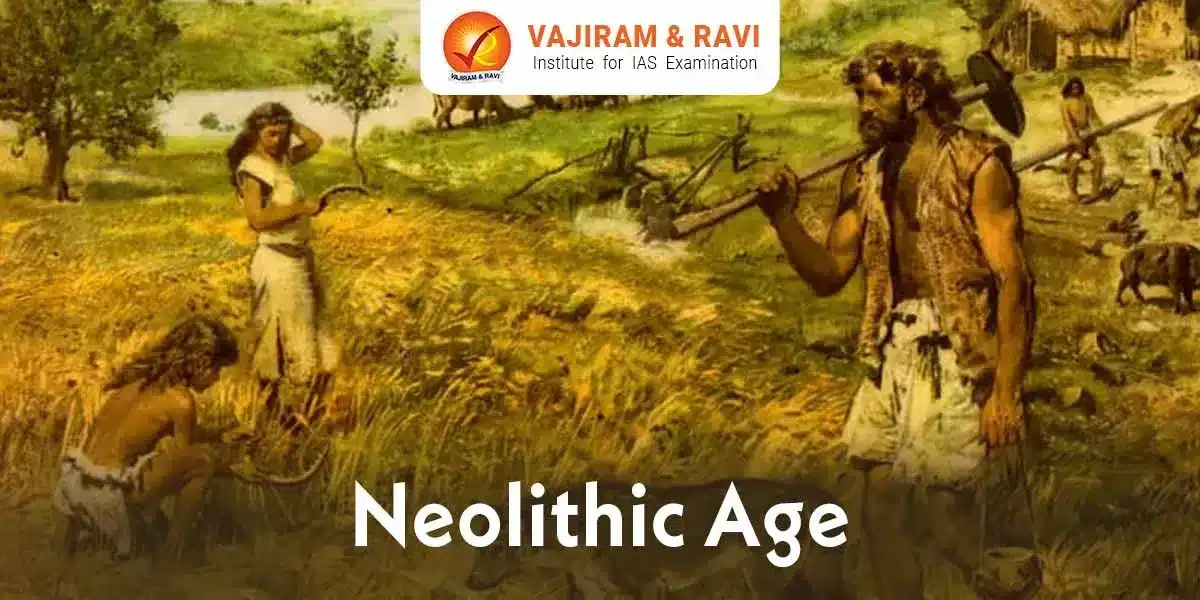The Neolithic period is the final stage of the Stone Age, after the Palaeolithic and Mesolithic. It is distinguished by several novel cultural features, such as the use of new technology to create stone tools, new means of subsistence, new patterns of housing, etc. Animal domestication and agriculture began during the Neolithic era. The Fertile Crescent region of Egypt and Mesopotamia, the Indus region, the Ganges valley of India, and China all contain early Neolithic cultural evidence. In these areas, agriculture first appeared between 10,000 and 5000 BCE, which started a number of cultural advancements.
Neolithic Age of Prehistoric Period
This new stone age developed in the Holocene epoch, preceded by the Mesolithic age. This prehistoric periodwas characterised by the development of agriculture, pottery, and permanent settlement, thus marking the beginning of the first human civilisation often termed the Neolithic Revolution.
- The Neolithic period was characterised by a cultural revolution. Man progressed from being a seeker of the natural world to its master.
- Tools from this period required more time to complete and were more durable. In addition to stone tools, the people brought ceramics, which served a variety of functions.
- Although they continued to use earlier tools, prehistoric people used pecking, grinding, and polishing to fashion tools from various types of igneous rocks during this period in order to adapt to their environment.
- The surface of a wet sandstone was used as an abrasive. The tools thus made were more durable and one took a longer time to make them.
- Thus, mostly the Neolithic industry is referred to as the pecked and groundstone tool industry.
Neolithic Revolution
During the Palaeolithic and Mesolithic stages, the mode of subsistence was hunting and gathering, which changed significantly in the Neolithic age.
- Technological advancement: The Neolithic period is associated with the advancement in stone tool technology, particularly the making of ground, pecked, and polished stone tools, and the advent of food production.
- Changes in the stone tools were in line with the changes in subsistence strategies.
- Started Sedentary Living: The emergence of small and relatively self-sufficient village communities, as well as a division of labour based on sex, resulted in a sedentary life for the first time in human history.
- Food production by artificial means: In the Neolithic age, humans started using artificial means to produce food for the first time.
- Agriculture and the domestication of animals were the two novel practices that developed at this time.
- Some wild animal species, like goats, sheep, and cattle, were domesticated and were being used for transportation and agriculture.
- Similar to this, early crops included wild varieties of paddy (especially in Asia), wheat, barley, etc.
- Agriculture proved to be such a significant invention that a small portion of society was able to provide the entire community with food.
- Pottery: Neolithic pottery was pioneering and made by hand at first, then using wheels.
- Weaving and spinning were also invented in this age.
- The Neolithic Age opened an entirely new way of life and sowed the seeds of civilisation. That is why this phase is called the Neolithic Revolution to highlight the enormous significance of these changes.
- This revolution was gradual and took place several times in different regions, with varied features and results.
The Neolithic Age and the Beginnings of Food Production
The domestication of plants and animals was the outcome of a long series of collective experiments spanning several generations of men, women, and children, stretching out over possibly thousands of years.
- It involved taking plants and animals out of their natural habitat and selectively breeding and raising them in controlled artificial environments for human benefit.
- The balance of subsistence strategies can be gradually observed to have shifted from hunting and gathering to agriculture and animal husbandry.
- The next stage was that of incipient (early) agriculture, which, over time, led to the stage of developed agriculture.
- Over time, these changes were linked to advancements in technology, increased food availability, population growth, an increase in the quantity and size of human settlements, and more intricate social and political structures.

Neolithic Culture in India
India's Neolithic cultures can be broken down into a number of regional groups, each of which had its own prosperous time. It started very early in the northwest regions of Pakistan and India. The Neolithic cultures emerged in north-eastern India towards the beginning of recorded history, which is a very late date.

| Neolithic Sites of North-Western Region and Features | |
| Mehrgarh (Kacchi Plains of Balochistan, Pakistan) |
- On the Bolan river bank. - Evidence of pre-pottery Neolithic culture - Settlement of semi-nomadic pastoral groups - People used polished stone axes, querns, microliths, and bone tools; however, they did not use pottery. - Cultivation of six-row barley, emmer, and einkorn wheat. Barley is likely to be the most important crop. - Domestication of sheep, goats, and cattle - Seeds of plum, dates, and jujube were found at this site, suggesting the gathering activities of the inhabitants. - The bones of gazelles, swamp deer, and antelopes indicate that they hunted wild animals too. Goat bones are also found. - They built their houses with mud and buried the dead in between the houses. - People used sea shells, limestone, turquoise beads, lapis lazuli, and sandstone as ornaments.
- Grinding stones and blades have been found. Evidence of bitumen in blades suggests the use of hafting. - Presence of a handmade female figurine. - Significance of Mehrgarh: The site provides the earliest evidence of the transition from hunting-gathering to animal domestication and agriculture. |
| Kashmir Valley Neolithic Sites and Features | |
| Burzahom |
- Pit houses to protect from the cold weather of the region - Coarse handmade pottery - From this place, a stone with an engraved picture of a hunting scene, the sun, and a dog has been discovered. - Evidence of grain storage has been found. - A perforated harvester with decoration has been found at Burzahom. - agate and carnelian beads - A wild dog bone and antler horn were found at the burial place - Seeds of wheat, barley, common pea, and lentils have been recovered - The domesticated animals include cattle, sheep, goats, pigs, dogs and fowl. |
| Gufkral |
- Evidence of pit dwellings. - Bones of sheep, goats, deer, ibex, wolf and bears suggest their dependence on pastoralism and hunting. - Material culture: As revealed from polished stone tools, querns, horn tools and steatite beads - The site dates back to 1300 BCE. |
| Neolithic Sites of Vindhya-Ganga Valley and Features | |
| Belan River Valley (modern Uttar Pradesh and Madhya Pradesh) |
- It witnessed one of the earliest Neolithic occupations in India. - Here, there is a noticeable shift from food gathering to food production. |
| Chopani Mando, Koldihwa, and Lehuradeva all in Uttar Pradesh |
- Evidence of wattle and daub houses, post-holes, microlithic tools, querns, pestles, and underfired hand-made ceramics. - The important ware was ‘corded ware’ or cord impressed ware including bowls and storage jars. - People engaged in farming and animal husbandry. - Bones of cattle, sheep, goats, deer, turtles, and fish have also been recovered. - At Mahagara, evidence of domesticated rice has been found. |
| Chirand, Chechar, Senuwar, and Taradih all in Bihar |
- Senuwar: evidence of cultivated rice, barley, field pea, lentil and millets. - Chirand: Evidence of mud floors, pottery, microliths, polished stone axes and terracotta human figurines.
|
| Other features |
- Sohagaura, Imlidih Khurd, Chirand, Chechar, and Senuwar give evidence of a Chalcolithic transition - In this region, copper seems to have been introduced sometime during the second half of the third millennium BCE. |
| Other Region Neolithic Sites and Features | |
| Eastern Region Sites |
- Birbhanpur (West Bengal) is an important Neolithic site in this region, along with Kuchai, Golbaisasan, and Sankarjang. - Evidence of shouldered axes, pointed-butt celts, and chisels - Similarities to East and Southeast Asian Neolithic Complexes - Mace heads, pounders, coarse red ware, cord-impressed pottery, floors, postholes and bones have been found. - Pandu Rajar Dhibi (West Bengal): suggests Neolithic culture had emerged from the Mesolithic context. |
| South India |
- Within South India's Neolithic complex, over 200 Neolithic sites have been identified. - Karnataka:Brahamgiri, Hallur, Kopagal, Maski, Piklihal, Tekkalkotta and Snagankallu. - Andhra Pradesh: Uttanur, Rampuan, Palvaya, and Nagarjunakonda. - Tamil Nadu: Paiyampalli. - Ashmounds: are a distinctive feature of this region. |
Life in Neolithic India
- Tools: All Indian sites possessed polished or ground stone axes. They also included earlier tools such as microliths and blades.
- Pottery: The early neolithic culture of a few sites, such as in Kashmir, Balochistan, and South India, was without any pottery. Later, earthen pots were the distinctive features.
- House: In the form of simple huts (across India) and pit dwellings (in Kashmir and Deccan). The huts were of various shapes - circular, rectangular, etc.
- Arts and crafts: Beads made of semi-precious stones and clay figures of animals and mother goddesses are notable items.
- Social organisation and belief system: People started to live in sedentary and semi-sedentary settlements.
- They probably had a tribal level of social organisation.
- As they domesticated plants and animals, the concept of land and plant ownership developed.
- The presence of small houses may suggest the presence of nuclear families.
- The ceramics and beads suggest an improvement in material cultural production.
- The dead were buried within the houses, and animal burials are sometimes found. It suggests the adoption of specific rituals and the worship of the dead.
- They may have worshipped the natural forces.
- The pieces of evidence of art objects are very few, but the terracotta images of cattle suggest some kind of fertility cult.
Last updated on January, 2026
→ Check out the latest UPSC Syllabus 2026 here.
→ Join Vajiram & Ravi’s Interview Guidance Programme for expert help to crack your final UPSC stage.
→ UPSC Mains Result 2025 is now out.
→ UPSC Notification 2026 is scheduled to be released on January 14, 2026.
→ UPSC Calendar 2026 has been released.
→ UPSC Prelims 2026 will be conducted on 24th May, 2026 & UPSC Mains 2026 will be conducted on 21st August 2026.
→ The UPSC Selection Process is of 3 stages-Prelims, Mains and Interview.
→ Prepare effectively with Vajiram & Ravi’s UPSC Prelims Test Series 2026 featuring full-length mock tests, detailed solutions, and performance analysis.
→ Enroll in Vajiram & Ravi’s UPSC Mains Test Series 2026 for structured answer writing practice, expert evaluation, and exam-oriented feedback.
→ Join Vajiram & Ravi’s Best UPSC Mentorship Program for personalized guidance, strategy planning, and one-to-one support from experienced mentors.
→ UPSC Result 2024 is released with latest UPSC Marksheet 2024. Check Now!
→ UPSC Toppers List 2024 is released now. Shakti Dubey is UPSC AIR 1 2024 Topper.
→ Also check Best UPSC Coaching in India
Neolithic Age FAQs
Q1. What is the Neolithic Age?+
Q2. What is the significance of Neolithic culture?+
Q3. What is the Neolithic Revolution?+
Q4. Which tools were used in the Neolithic culture of India?+
Q5. What were Neolithic tools made of?+
Tags: neolithic age quest

















